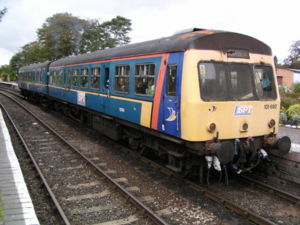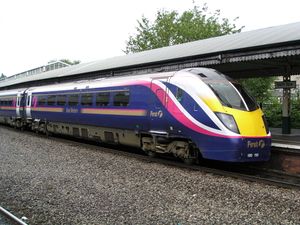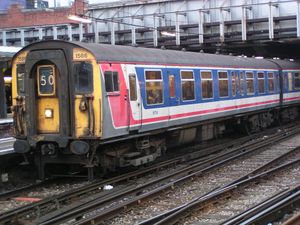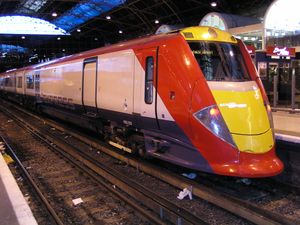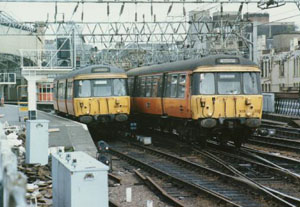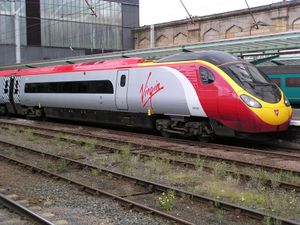British diesel and electric multiple units
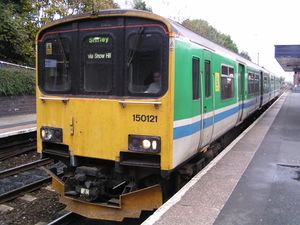
Contents
Definition
'Multiple Unit' is a term used to describe a train which does not have a separate locomotive. Typically these are passenger trains with accommodation in every vehicle and motors or engines distributed under the floor along the length of the train.
The term is also used, more loosely, to describe a train such as the Advanced Passenger Train which was a permanent formation with 'power cars' in the train rather than a locomotive at one end.
Electric Multiple Units
3rd rail Electric multiple units (E.M.U.s)
The Southern Region of the now-disbanded state monopoly British Rail has mostly used electric multiple units since the late 1920s - mainly consisting of 2 electrically powered carriages with a cab unit at one end, often pulling 2 non-powered carriages coupled between them. These trains were fairly reliable, based more on evolution rather than innovation. Even when they were finally phased out in 2005 after up to 40 years' service, the reliability was still extremely high. But their Mark 1 bodyshells did not meet tightened crashworthiness regulations and their manually-operated 'slam doors' were a source of accidents and delays - typically station staff would have to walk the length of the train before departure to ensure all the doors were completely closed. Some have been preserved by South West Trains on a branch line in Hampshire. Some had a black, orange and Grey 'South Eastern Express' livery in the early 1980s, which was often called the 'Jaffa cake' livery.
Later models had air-assisted sliding-doors added to them. In the late 1970s, new prototype 4Pep trains were issued with air-assisted sliding-doors. These followed by a temporary batch of Class 508 before the production batch of Class 455 units was delivered (The 508's being transferred to Liverpool). These trains were nicknamed 'push-button' units since they were the first in the region to have passenger-operated push-button sliding doors. London Underground, on the other hand, let the drivers open them from the cab controls instead.
In the 1980s the third rail was extended to Weymouth, around the same time the decision was taken replace to the powerful (3200hp!) 4Rep tractor units and 4TC trailers, which were built from redundant loco-hauled stock. However the budget did not permit the construction of completely new units. The decision was taken to salvage the relatively modern electrical equipment from the elderly bodywork and combine it with an improved version of the Mark 3 HST carriage. The central motor coach was based on an Irish generator van with the required floor strength for the traction equipment. The result was the Class 442 Wessex Electric, with a high speed officially of 109mph (during testing, though it has been known to achieve higher). These have proved popular with both enthusiasts and passengers.
Overhead power line E.M.U.s
The 25Kv overhead line powered units used a pantograph, to conduct power to a motor coach usually located in the centre of the train. The Driving Cars and the other vehicles were sometimes unpowered. They were used all over Britain's railways from the mid 1950s. Some ran on 1500 volts (1.5Kv) power supplies, but these were all converted in the 1980s. In the late 1990s Virgin West Coast ordered a fleet of 140mph tilting 'pendolino' EMUs, these began to enter service in 2002.
Diesel multiple units (D.M.U.s)
These units were similar to the electric third rail variety of E.M.U.s except that some or all of the carriages have a diesel powered internal combustion engine under the floor. They are not prone to track flooding like the 3rd rail units or high winds dislodging cables like the over-head powerline units, but the Rolls Royce engines fitted to 1st generation units do make a lot of diesel fumes and sooty particulates. The Heritage D.M.U. units and later Pacers, Sprinters, and Turbos were all used throughout the country. In the late 1990s, the early Pacers Class 141 were withdrawn. Only one heritage unit is still in regular use with Chiltern Railways. D.M.U.s have been used on all regions of British rail since the late 1940's.
First Generation DMUs
As part of the 1955 modernisation plan of British Railways, provision was made for a number of railcars or DMUs. The earliest of these were the "Derby Lightweights", built by BR's own Derby works, and they quickly became popular with crews (for the increased comfort compared to a steam loco), operating authorities (they were, and still are, cheaper to operate than a loco hauled train, and are much more flexible, requiring no run around) and passengers (they were much cleaner than the old steam hauled stock and if you were lucky enough you could get a view of the line ahead).
Over the next few years a number of different designs came about, though nearly all were able to operate together thanks to BR standardising on the 'Blue Star' coupling code for multiple working. Although there were a few design differences, the units could basically be classified as suburban (Doors for each seating bay, 3+2 seating in second class- an example is Class 118), Medium Density (2 doors per vehicle side, 3+2 bus style seating in second class- an example is Class 114), Cross Country (externally similar to Medium Density, 2+2 bus style seating in second class- an example is Class 120) and finally Intercity (Interiors to same standard as loco hauled stock- an example is Class 124).
Today around 300 vehicles survive in preservation, various vehicles (mainly 101s and 121/122s) survive in departmental use, and Chiltern Railways use a Class 121 on its Aylesbury-Princes Risborough Line.
Anyone with an interest in these trains is highly recommended to visit The Railcar Association's website
Second Generation DMUs
By the early 1980s it had become apparent that the Modernisation Plan DMUs were showing their age, and needed replacement or refurbishment. As several were insulated with blue asbestos, which BR was obliged to eradicate from its stock, the problem was compounded. BR designed two quite different trains as attempts to solve the problem, one being the Class 140 (Prototype Pacer) which was basically a Leyland bus body mounted on an improved wagon chassis- a low cost design, and the other being the two Class 210 Diesel Electric Multiple Unit, which was similar to the mk3 coach based Class 317 EMU, with the addition of an above floor Diesel Electric prime mover. Though the 210 was a well engineered unit which proved popular with the public, it was simply too expensive for mass production, and so with improvements the Class 140 led to the Pacer family of units, and subsequently a compromise between quality and cost was reached with the Sprinter family of units.
Pacer units
- See Main Article Pacer (train)
These units were generally regarded as a bit of a design error and were made up of diesel powered road bus parts. They were meant as a cheap replacement for the worn out Mk1 D.M.U.s, but were largely proven to be inferior to the trains they were replacing-not least the hard seats and loud engine noises. Later models were significantly improved. Later Pacer rail-buses have proven successful and are still in use in South Wales, Manchester, Liverpool and Yorkshire.
Sprinter units
The Sprinter family is the highly versatile successor to the pacer. Using technology proven on the continent in the form of Cummins engines and a Voith hydraulic transmission gave the extremely high reliability required. There are 6 types of Sprinter (plus a prototype for a seventh type that didn't make it into production). The first type to enter service was the BREL British Rail Class 150 with a high density layout suitable for short suburban services, quickly followed by the 150/2 with gangway between units and improved interior. For longer distance journeys there were the Leyland Class 155 and Metro-Cammell Class 156. These were fully carpeted with end doors, luxury unheard of at the time on the routes they operated. The class 155 units were later split into two single car units with a new and very compact cab being grafted onto the inner ends forming Class 153. The conversion was undertaken by Hunslet. The class 153's are used on rural branchlines and for strengthening other services. For regional services the Class 158 was built. This offered near intercity levels of comfort with full air conditioning and a quiet interior. The last of the Sprinters to be built was the Class 159 for Network South East for use of the West of England Main Line between Exeter and London Waterloo. These were three car versions of the Class 158 with an upgraded interior.
Turbo units
The Turbo family was originally a standardised model for diesel suburban services around London. There were two types, the first Class 165 was a two or three coach unit used on the Chiltern and Thames routes. This was followed by the Class 166 which featured air conditioning and seating more suited to longer distance services. These designs later evolved into the ABB/Adtranz/Bombardier Class 168 Clubman and Class 170/171 Turbostar which operate local and regional services throughout the country.
Coradia
The Coradia is a family of multiple units produced by Alstom. The British diesel versions are the 100mph Class 175 for First North Western's North Wales Services (later moving to Arriva Trains Wales) and the 125mph Class 180 Adelante for First Great Western's semi fast services. Both types have had a protracted entry into service in common with other Alstom trains.
Desiro
While the Siemens Desiro has quickly established itself as an Electric train , the diesel version for Transpennine Express (Class 185 Pennine) is in service. The first train was unveiled in Germany in November 2005 and arrived in the UK a month later. The first train went into public service in March 2006 with deliveries of the 51 strong fleet continuing into 2006, and being complete in December 06, now ALL 51 units are in operation
DEMUs
1st Gen (Southern)
The Southern Region of British Rail preferred Diesel Electric Multiple units for use on non electrified routes. Routes they were used on included London to Hastings (now electified), London to Uckfield, Portsmouth to Southampton (now electrified) and Southampton to Salisbury. Each Unit consited of a motor coach and a number of trailers in formations of between two and six coaches depending on the type.
Class 210
The British Rail Class 210 was a prototype DEMU. It was based on the then standard design of EMU (Classes 317 and 455) with a diesel engine mounted at the end of one of the driving cars. It was not a success due to weight and cost and the decision was made to order diesel hydraulic Sprinters.
Voyager Family
The Voyager family is a series of high speed DEMUs. Virgin Trains were looking to replace the Cross Country fleet as part of their franchise obligations. The new train had to replace a mixture of life expired loco-hauled trains and mid-life HSTs and have tilt for use on the West Coast Mainline. The result was the non-tilt Class 220 Voyager and tilting Class 221 Super Voyager. While the introduction to service was relatively problem free, the shorter trains quickly became overcrowded and reliability has become the poorest of the high speed DMUs, an example being the section of line along the South Devon coast still has problems with salt spray getting into the electrics and shutting the engines down. Midland Mainline and Hull Trains since ordered a non-tilt version. The Class 222 Meridean and Pioneer units replaced slower Turbostars on semi-fast mainline services. The Class 222 does average much higher reliability than the Virgin units, this is possibly due to the later build taking account of problems encountered in the earlier units with cross feeding power and the omission of tilt capability. Unlike previous designs of DEMU the Voyager family have underfloor engines instead of having an engine compartment behind a driving cab.
British Rail diesel multiple units | |
|---|---|
| First generation units: | |
| First Generation Original TOPS: | |
| First generation units (pre-TOPS): | |
| Second generation units: | |
| Diesel-electric units: | |
| Southern Railway designations: | |
| Families | |
Sources
Platform 5 books
- Locomotives and coaching stock of 1986.
- Locomotives and coaching stock of 1998.
- A.B.C. book- Diesel multiple units- 1979.
